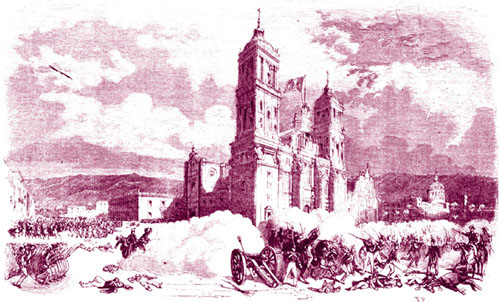LST 1159s Namesake
Tom Green County is a county in western Texas, established in 1874 and named in honor of Brigadier General Tom Green of the Confederate Army. LST 1159 has been named after this heroic figure in American history. It seems only fitting that our amphibious ship be named after a a man that performed well on both the land and on the water.
Tom Green
|
 |
In 1835 at age 21 Tom Green first came to Texas. Over the
next twenty nine years he would prove to be one of the most
courageous men in Texas.
Green was born in Virginia on June 8, 1814, but moved with
his family to Tennessee at an early age where first he
attended Jackson College in Tennessee. Later he attended
Princeton College in Kentucky. He then graduated from the
University of Tennessee. Then after studying law for about
a year, he left Tennessee to join the Texans in their
struggle for independence.
Green entered the Texas army at Nacogdoches, a few months
before the Battle of San Jacinto. At that historic
battle, Green helped man one of the "Twin Sisters"
artillery pieces.

This momument comemorates the 1836 Battle of San Jacinto. Texans consider this battle one of the most important battles in their war of independance from Mexico. To this day, April 21 is celebrated as San Jacinto Day.
In the new Republic he participated in several frontier skirmishes with the Indians, and accompanied General Alexander Somervell to Mexico in the ill-fated Somervell Expedition.
In the Mexican-American War, Green raised a company of volunteers and participated in the taking of Monterrey.

The Taking of Montery
Green then settled back into a more normal life during the early years of statehood. He married, began a family, and served as clerk of the Supreme Court of Texas. The Cival War marked the end of this peaceful period of Greens life.
Green entered the Civil War as a colonel in the brigade of General H. H. Sibley. Early in the War, the brigade saw service in New Mexico. On January 1, 1863, Green was back in Texas and led the forces on board the two Texas "cottonclads" used in the Battle and recapture of Galveston.
After the success at Galveston, Green and his men participated in several major battles in Louisiana, including the Battles of Mansfield and Pleasant Hill in early 1864.
Green was next transferred to Louisiana, where he won renown as a cavalry leader. Some officers said that he was second only to J.E.B. Stuart. At the battles of
Mansfield and Pleasant Hill, Green's Brigade conducted forays and guerrilla warfare, harassing Union supply lines and rear areas.
In the spring of 1864, during a Federal drive to cutoff Texas as a storehouse of supplies for the Rebel cause, Green led his men in an ill-fated cavalry charge on Union gunboats at Blair's Landing, La. on the Red River. On this day, 12 April 1864, while leading the cavalry charge to the very bank of the river, Green was decapitated by shellfire.
Admiral David Dixon Porter paid tribute to the fallen Confederate cavalryman in saying that Green was "one in whom the rebels place more confidence than anyone else. He led his men to the very edge of the bank, they shouting and yelling like madmen-losing General Green has paralyzed them; he was worth 5,000men to them."
